One of the most recognizable plants you can grow is the bleeding heart. Their heart-shaped blossoms are unmistakable, and can add unique beauty to your garden.
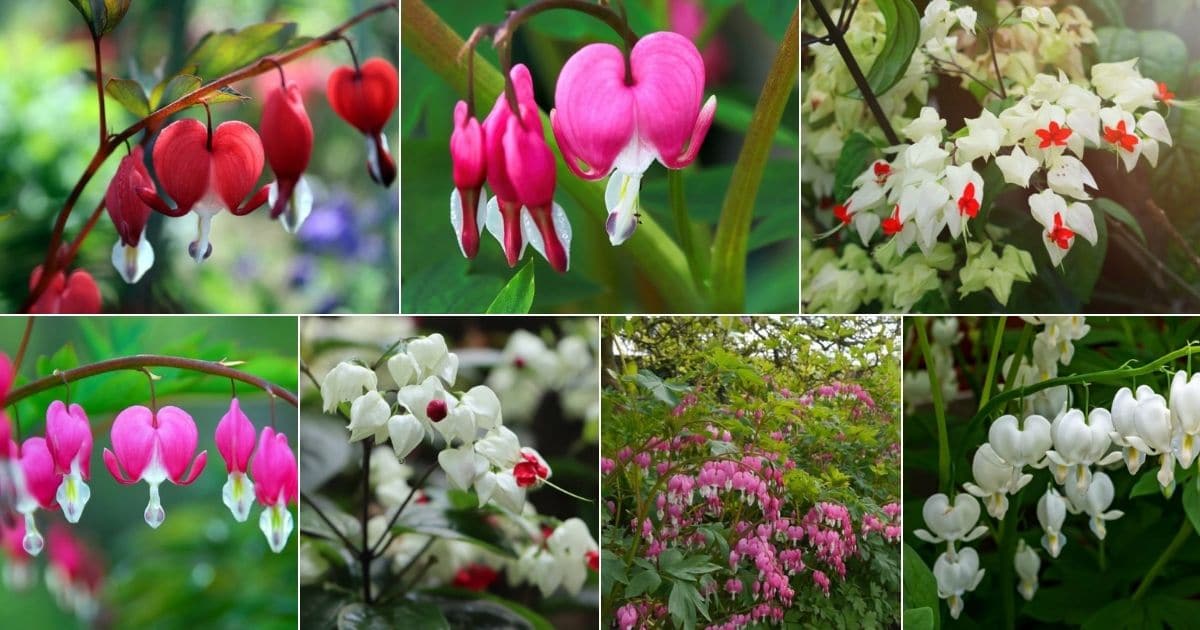
In this full growing guide, we are going to teach you what you need to know to grow bleeding hearts. They are a great choice for gardeners looking for something for a shade garden in particular.
We will start by introducing you to this perennial, and then tell you about the different types of bleeding hearts.
We will then press on to discussing bleeding heart bloom periods, ideal growing conditions, and how to plant and care for these flowers.
Let’s begin!
Jump to:
- What Are Bleeding Hearts?
- Bleeding Heart Basics
- Where Do Bleeding Hearts Grow?
- Why Grow Bleeding Hearts?
- Do Bleeding Hearts Have Drawbacks?
- Recommended Bleeding Heart Varieties
- When Do Bleeding Hearts Bloom?
- How Long Do Bleeding Hearts Bloom?
- Ideal Growing Conditions for Bleeding Hearts
- When to Plant Bleeding Hearts
- How to Plant Bleeding Hearts
- How to Care for Bleeding Hearts
- How to Divide and Transplant Bleeding Hearts
- Recommended Companion Plants for Bleeding Hearts
- Frequently Asked Questions About Growing Bleeding Hearts
- Where to Buy Bleeding Hearts
What Are Bleeding Hearts?
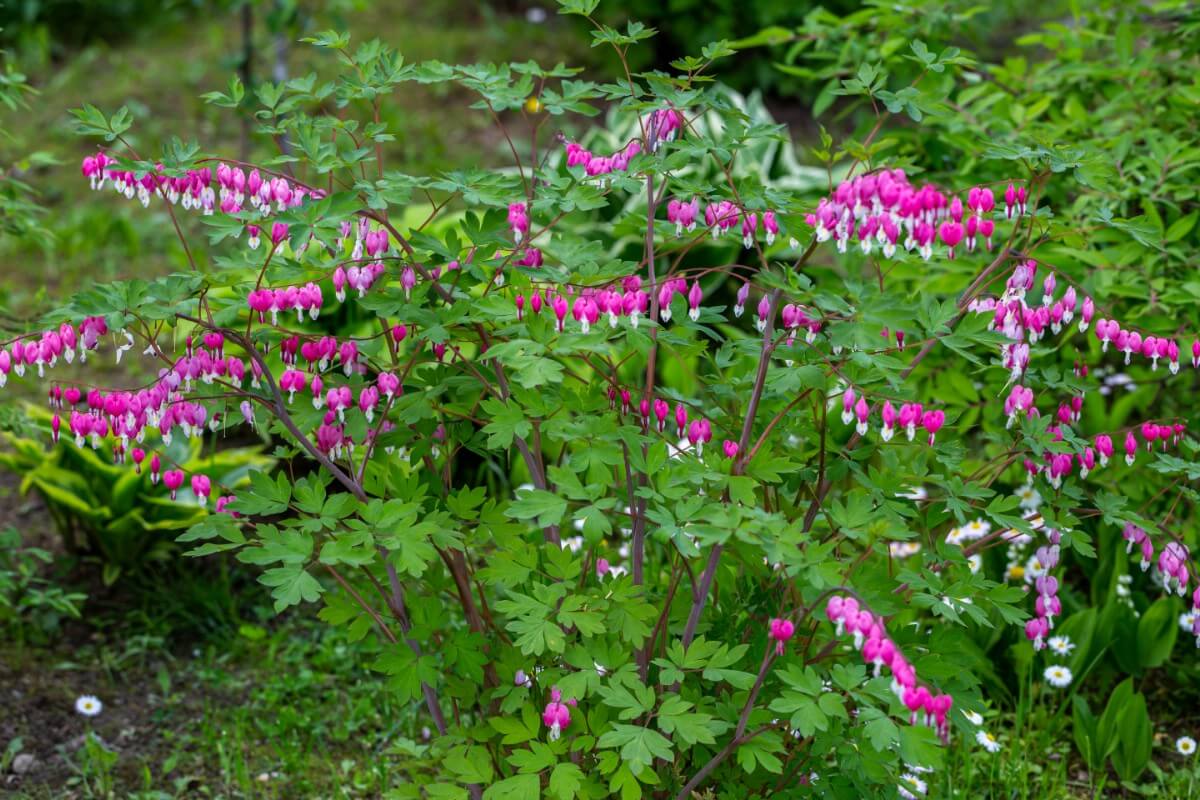
Bleeding hearts are a genus of plants with the scientific name Dicentra. There are only eight species within the bleeding heart genus. But there are a larger number of cultivars.
The name “bleeding heart” refers to the heart-shaped flowers that this plant produces. The petals form what looks like a “drop” at the base of each, thus the “bleeding” reference in the name.
Rows of the drooping red, pink and white blossoms hang along the stems. Their weight causes each stem to dip in a gentle, elegant curve. Thus, it is not only the blooms that are beautiful, but also their arcing formations.
While these plants are usually called bleeding hearts, there are a few other names you might occasionally hear them called.
Some examples include tearing hearts, our-lady-in-a-boat, lady’s locket, lyre flower and Chinese pants.
The bleeding heart is gorgeous to behold, but also entirely toxic. So, if you have children or pets, take care that they never eat them for any reason. The stems, the leaves, and the flowers are all poisonous.
Bleeding Heart Basics
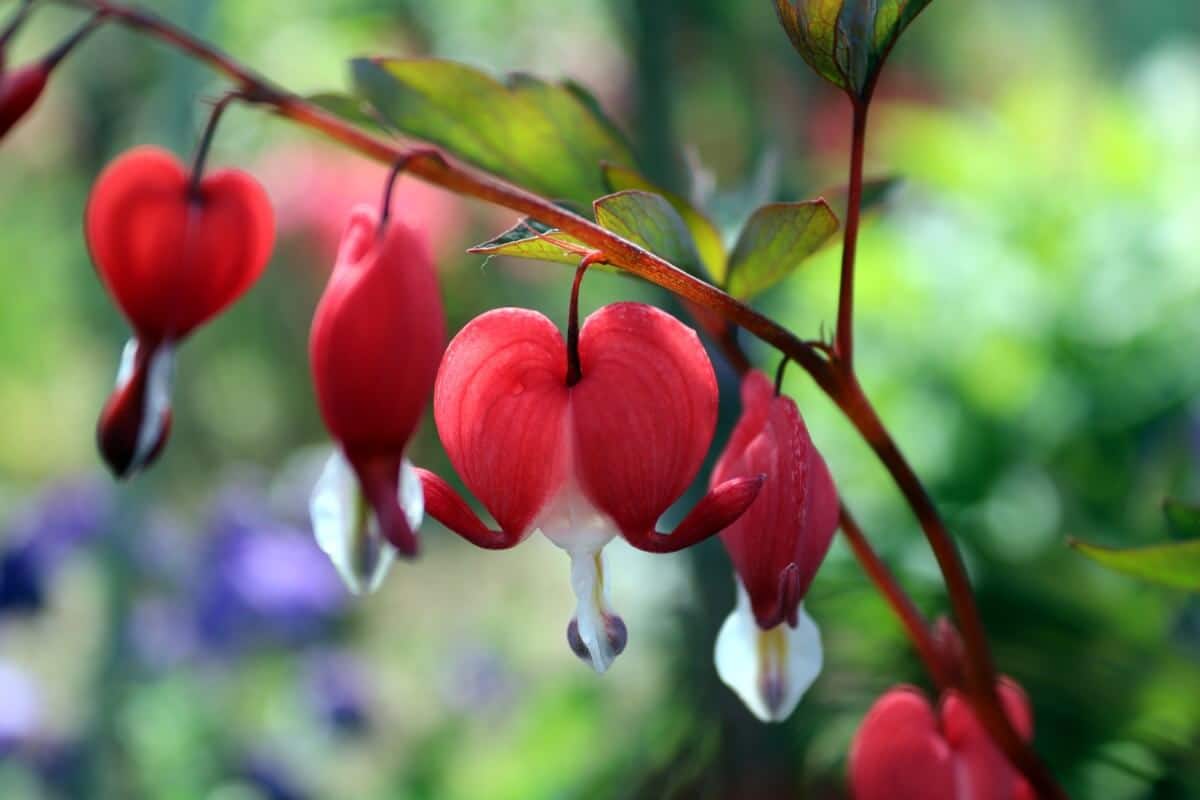
| Zones: | 3-9 |
| Blooming season: | Spring |
| Expected height: | 6 inches to 4 feet (depending on variety) |
| Soil: | Any |
| Sun: | Shade |
Where Do Bleeding Hearts Grow?
Bleeding heart plants are native to North America and the eastern part of Asia. But they can be cultivated anywhere in zones 3-9. That gives them a pretty wide geographical range, and makes them suitable for many different climate conditions.
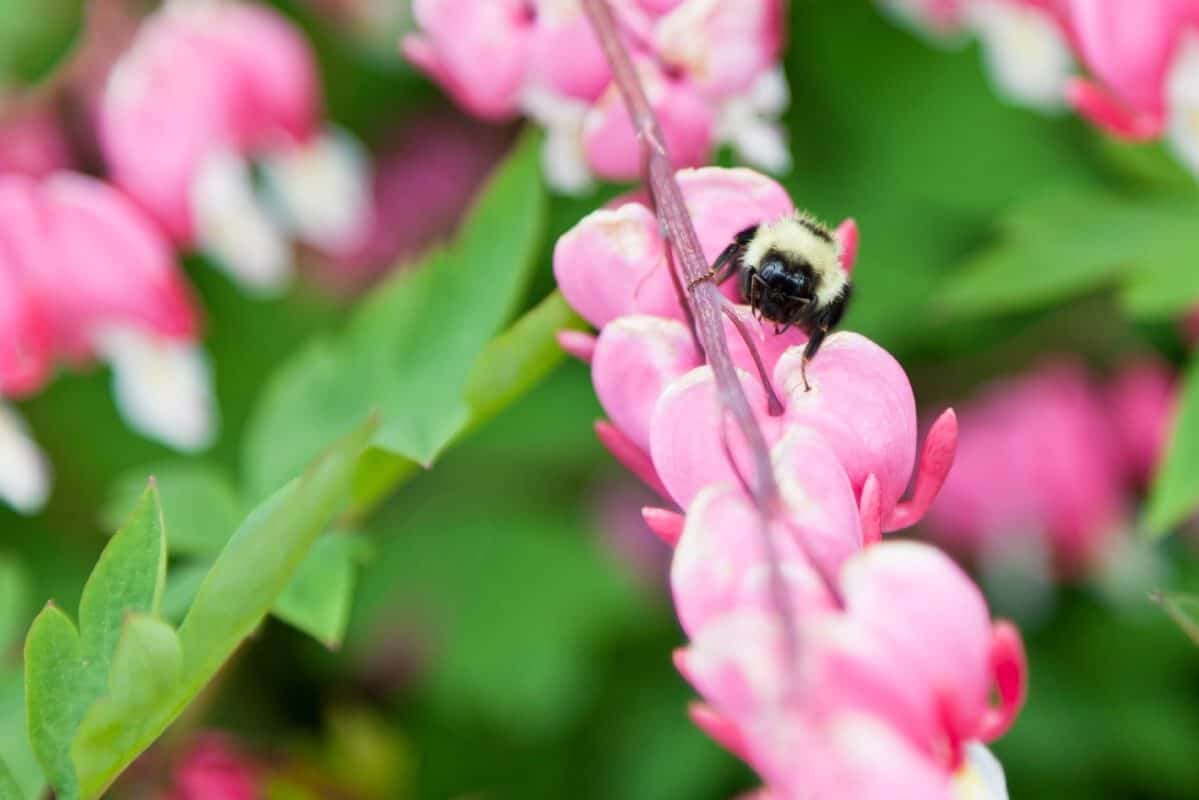
Why Grow Bleeding Hearts?
What are some great reasons to grow bleeding hearts? Here are their benefits:
Bleeding hearts adapt well to varying conditions. Pretty much regardless of your soil type, they can thrive with proper care. They are hardy in harsh climates.
The look of bleeding hearts is truly unique. With their striking shapes, they cannot be mistaken for any other flowers. They will stand out from those around them, drawing the gaze of all who explore your garden paths.
Butterflies love bleeding hearts. That means that planting these perennials may help to attract some colorful new guests to your garden.
Birds also are attracted to bleeding hearts. So, if you are a birdwatcher, this plant is an excellent one to add to your yard.
Have a lot of shade in your garden? If you have been having a hard time finding plants that will thrive in full shade conditions, you can turn to bleeding hearts. These plants prefer more shade than sun, and should make for a spectacular display.
If you live in a humid climate, you should find that your bleeding hearts are able to stand it pretty well (of course, they still need adequate spacing to have room to breathe).
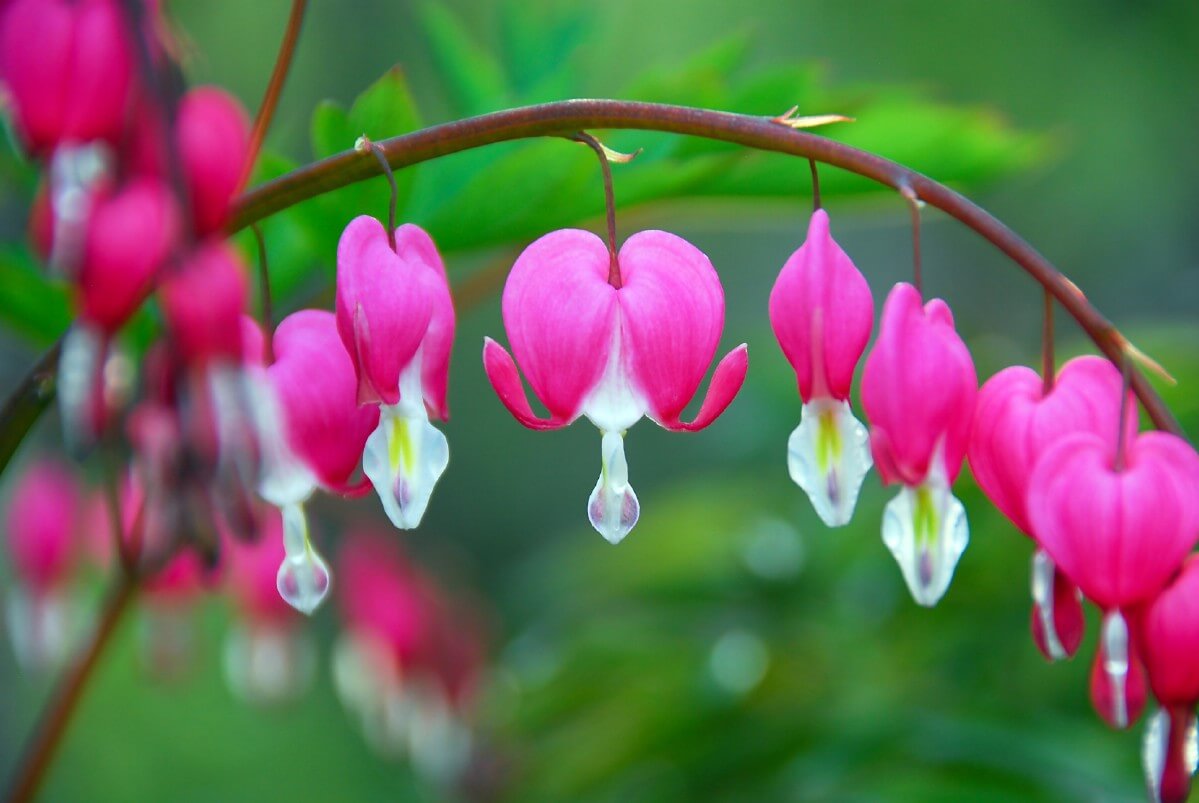
This plant is a solid deer-resistant option. Deer are more than happy to try eating most of the plants in your garden. If you are tired of that, you might find bleeding hearts refreshingly easy to protect. Indeed, these deer-resistant plants do a pretty good job of protecting themselves.
Bleeding heart flowers are beautiful in a floral arrangement. If you like cutting flowers from your garden to display in a vase, bleeding hearts can add an elegant touch to your arrangements. Not only that, but you will be impressed by how long they can last. They can look beautiful for as long as 2 weeks.
Bleeding hearts work as potted plants or plants in your garden beds. It is up to you how you prefer to grow them.
Want plants that spread, but not like wildfire? Bleeding hearts offer an ideal balance in this respect. The University of Wisconsin-Madison writes, “Plants will often self seed but do not do so readily enough to be considered invasive.” So, you will be pleased to watch new bleeding hearts coming up on their own, but will not be at risk of losing control of them.
Do Bleeding Hearts Have Drawbacks?
While bleeding hearts are wonderful additions to shady gardens, they do have some potential disadvantages to be aware of:
These plants are toxic. Their toxicity may be a concern if you have pets that go out in your yard.
Bleeding hearts die back dramatically each year. The gap they leave behind may be an eyesore if you do not fill it.
Transplanting bleeding hearts is quite difficult. They are less likely to survive the process than some other types of plants.
The blooms may fade fast in hot weather. Too much sun and heat can result in abbreviated bloom periods.
Some people may find that if they touch bleeding heart plants, their skin is irritated by the contact.
Recommended Bleeding Heart Varieties
Now that you know more about the pros and cons of growing bleeding hearts, let’s take a look at some of the varieties you can put in your garden:
King of Hearts: One of the most popular types of bleeding hearts you can buy is the “King of Hearts.” This variety has a vibrant pink color. But the beauty of the pink flowers is only part of the allure of this variety. Fans of this cultivar also love its intriguing blue leaf color. But you can also deadhead the King of Hearts bleeding hearts and get an extended bloom season out of them.
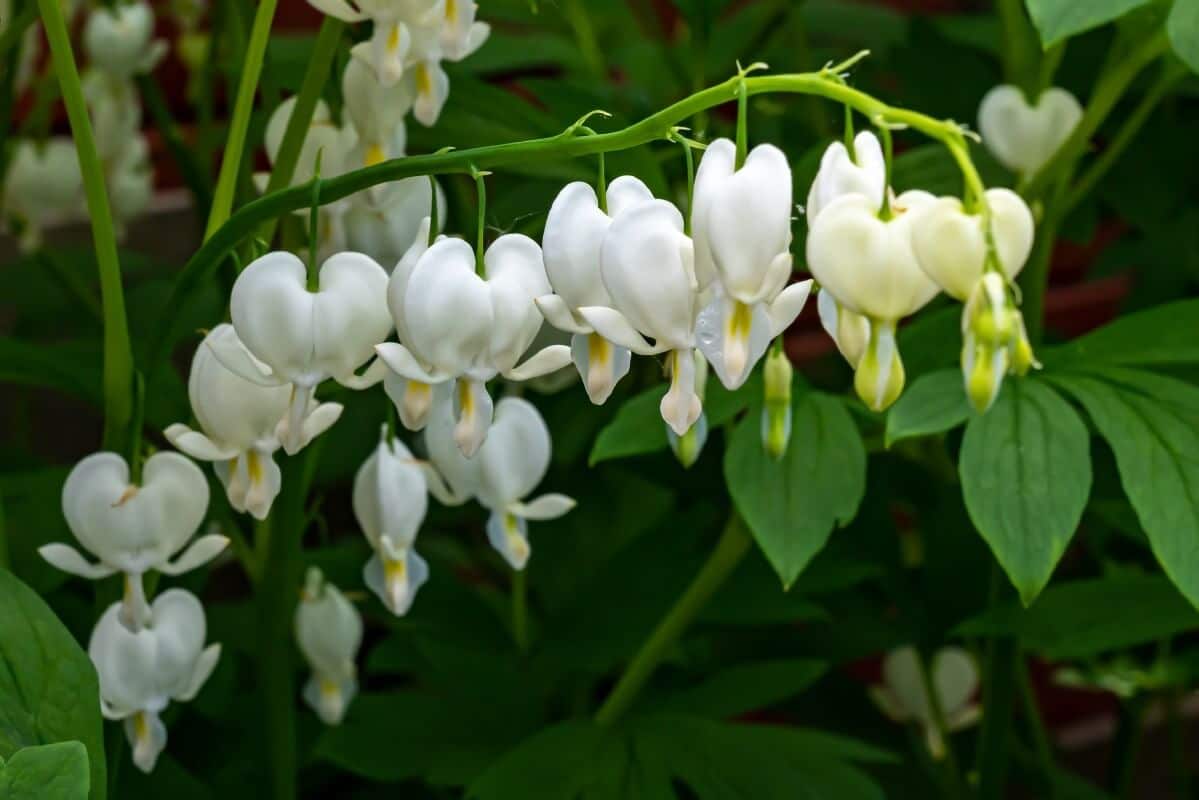
Alba: Are you looking for a bleeding heart cultivar that features white flowers? You will love the ethereal splendor of the graceful “Alba.” The white heart-shaped blooms can put up with hot summer weather better than some other bleeding hearts.
Gold Heart: Along with beautiful dangling, heart-shaped blooms, the “Gold Heart” variety of bleeding heart plant features attractive golden-green leaves. Many people select it for its foliage as much as for its flowers.
Pearl Drops: If you want another type of white bleeding heart with breathtaking blooms, “Pearl Drops” are worth thinking about. Unlike Alba blossoms, these ones are not entirely white. They have just a bit of pink going through them. It is also a pretty long-blooming type of bleeding heart.
Red Fountain: You have probably noticed that some bleeding hearts lean more toward red than pink. If that is the look you want for your garden, “Red Fountain” is a romantic variety you will fall in love with. The heart-shaped crimson flowers are a deep red with just a hint of white around the edges of the petals.
Komakusa: The flowers that this stunning plant produces have a delicate look to them. If you cannot decide between pink, white and red bleeding heart flowers, they are an excellent choice that combines all of these shades.
Ivory Hearts: This variety of bleeding heart is well-described by its name. The flowers have an ivory color.
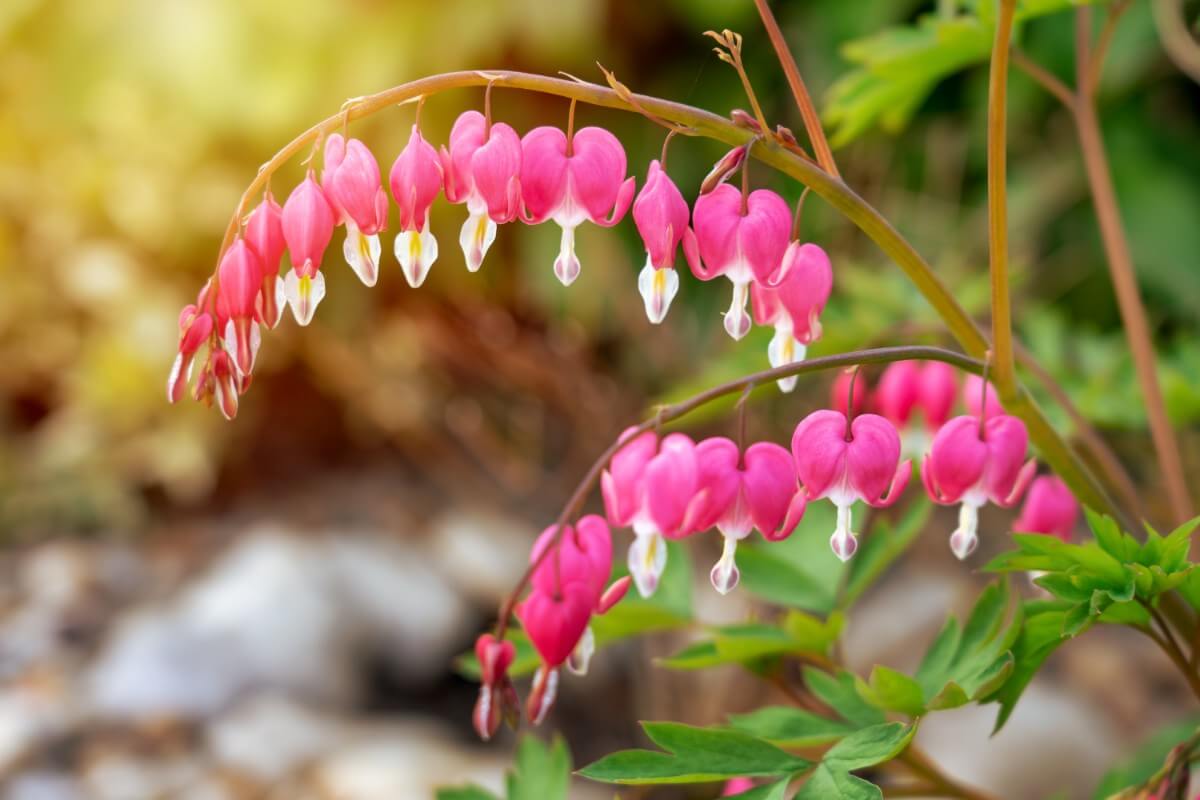
Pacific Bleeding Heart: This pink variety of bleeding hearts thrives in the Pacific region, but can grow anywhere in zones 3-9. Also, the pink, heart-shaped flowers sometimes have a purplish tint, which makes for a unique flower color.
Silversmith: Another variety of this woodland plant that you might want to consider is called “Silversmith.” The white flowers of this cultivar have a somewhat silvery sheen to them, thus their name. Make sure they are in a cool location, since they hate the summer heat.
Now you are familiar with some of the most beautiful and distinctive types of bleeding heart plants. But there are other cultivars to explore as well.
Any one of these varieties of bleeding hearts can make a beautiful addition to your shade garden! If you cannot find the one you want at your local garden center, check online. That is where you will find the widest selection of bleeding heart varieties.
When Do Bleeding Hearts Bloom?
You can expect your bleeding hearts to blossom in the spring when the weather is still not too warm.
How Long Do Bleeding Hearts Bloom?
The bloom period for bleeding hearts typically is several weeks. But it may be shorter if conditions are not ideal. Try to plant them in the most suitable locations for long-lasting beauty.
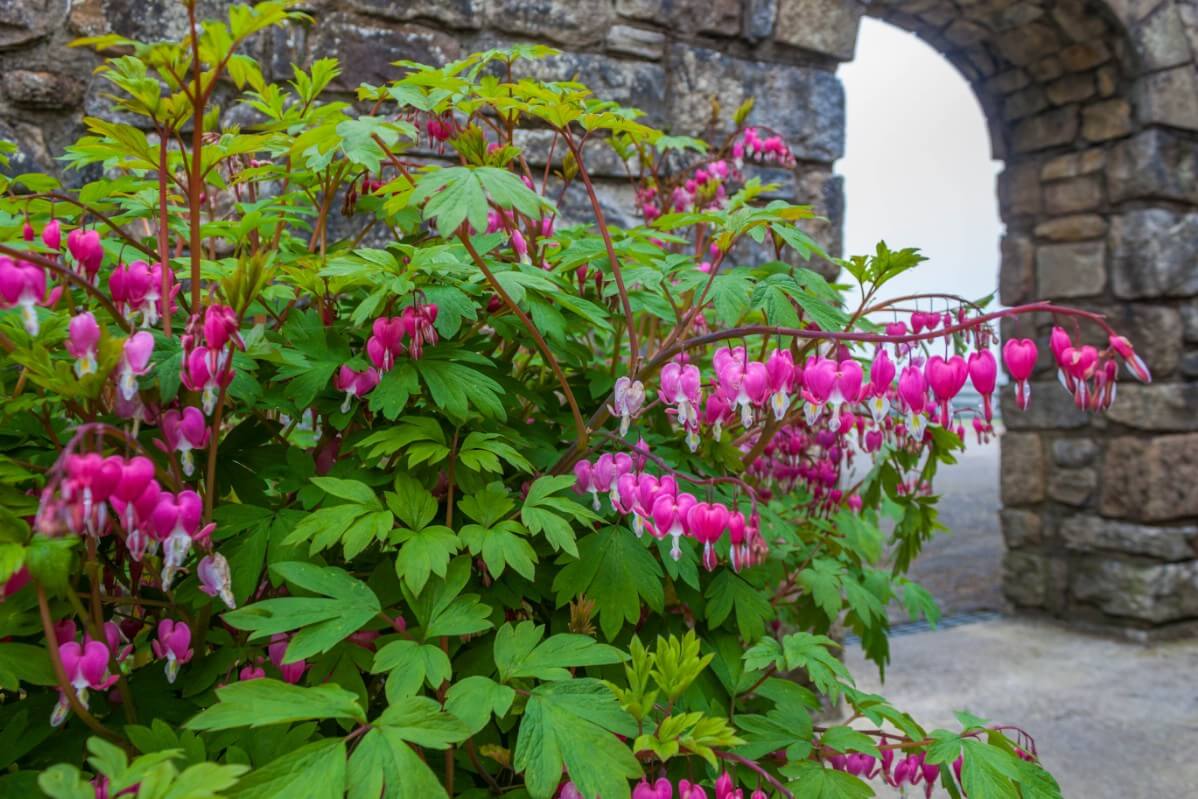
Ideal Growing Conditions for Bleeding Hearts
Having talked about bleeding heart bloom time, let’s now discuss the ideal conditions in which to grow bleeding hearts.
How Much Sun Do Bleeding Hearts Need?
Bleeding hearts are happiest in a shady garden. In fact, the heat of summer can cause premature wilting of the blooms. So, partial shade or full shade is what you need for thriving plants.
Can you grow bleeding hearts in full sun? In most locations, the answer to this question is “no”—at least if you want them to offer you weeks of blossoms to enjoy.
That being said, there are some locations where you might get away with this. If your climate is sufficiently cold, the sun may not overheat the plants.
What Type of Soil is Right for Bleeding Hearts?
Not surprisingly, bleeding hearts like moist soil. But while you should keep the soil moist, you should also allow it to drain. Like most other plants, bleeding hearts do not want wet feet.
If you have slightly acidic soil, that is ideal—a pH of around 6.0 to 6.5 is great. But if your soil is neutral, that should be all right as well.
How Much Water Do Bleeding Hearts Need?
Consistent moisture is critical for the well-being of your bleeding hearts. Again, you do not want the soil to be soggy, but you do want to make sure it doesn’t dry out.
That means that during the summer, you probably are going to need to water your bleeding hearts about once each week. You can check the soil too see whether it is adequately moist or you need to add more water.
Take note that if you are trying to grow bleeding hearts in full sun, the usual weekly watering that would be acceptable in partial to full shade may not be sufficient. In fact, you might even need to water them daily.
When to Plant Bleeding Hearts
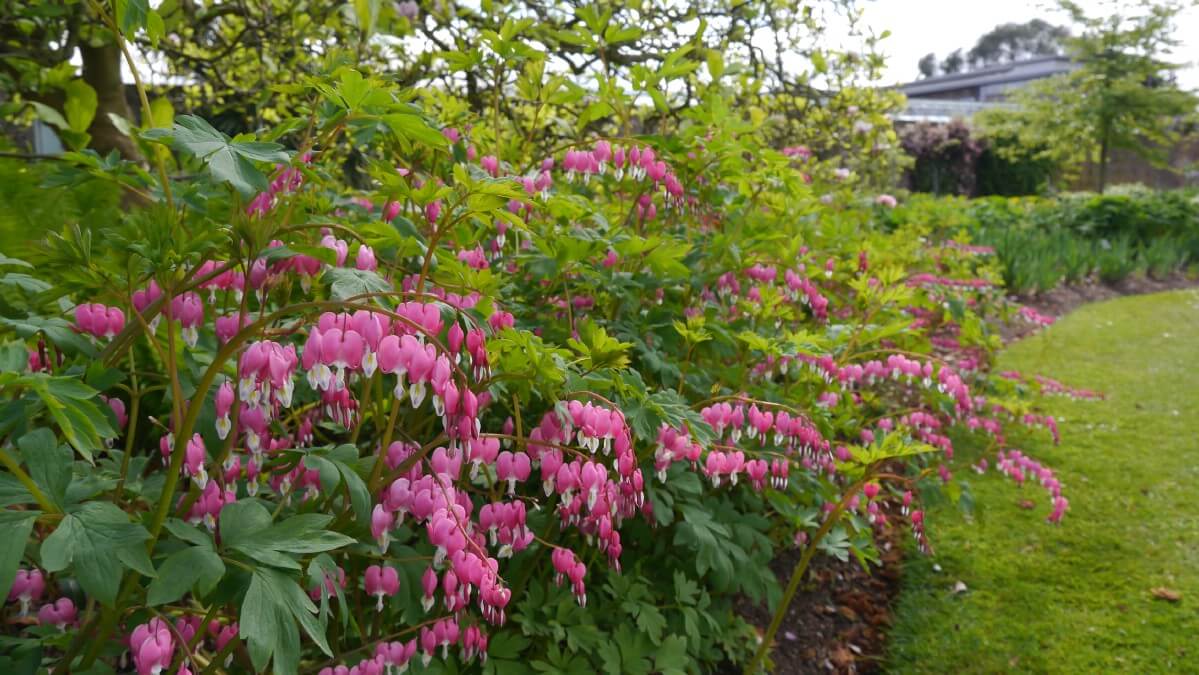
The right season to plant bleeding hearts is during the spring. Make sure that there is no further frost likely before you put them in the ground.
Like most other garden plants, they need time to establish themselves, and frost can kill them while they are trying to do so.
How to Plant Bleeding Hearts
Now you know what soil type, sun, and water are ideal for growing bleeding hearts. But how do you plant them?
We are happy to say that bleeding hearts can grow well in your garden plots or in containers. Let’s go over how to plant them in a pot, and then we will discuss how to plant them directly in your garden beds.
Note that bleeding hearts typically are planted as bulbs, but you can also start them as seeds. We will talk about bulb planting first, and then we will go over starting them from seeds.
In either case, as just mentioned, the best time to plant bleeding hearts is during the spring. Make sure that the last freeze is behind you, and then you can get to work.
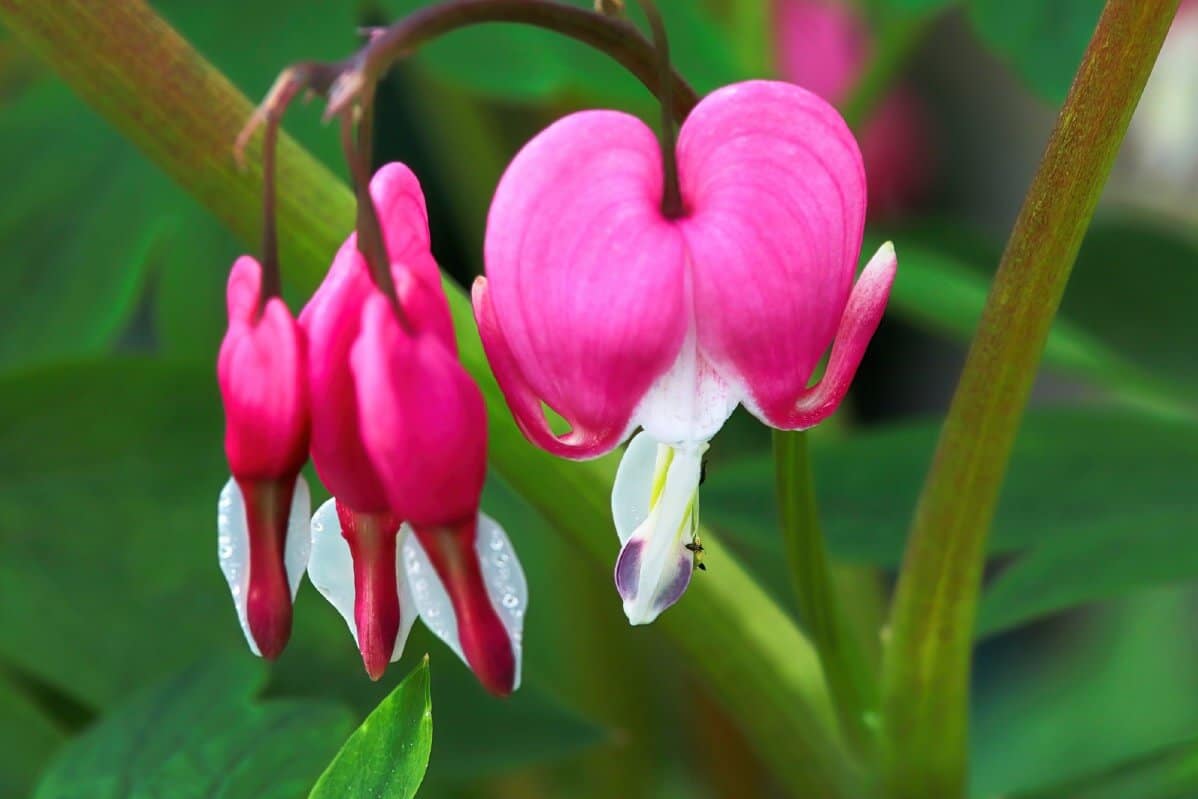
Container Planting
1. Start out by choosing the right container.
Bleeding hearts are relatively self-contained, but that does not mean they cannot get to be voluminous.
For that reason, you are going to need a pretty big container. It needs drainage holes, so add them if they are not already there.
2. Pick the right type of bleeding heart.
The Dicentra Formosa type of bleeding heart is generally the best option for container planting. It should not get to be more than about 1.5 feet tall.
3. Put your potting mix in your pot.
What type of potting mix should you go with for bleeding hearts? You want something rich that can retain moisture, but also drain effectively. That might mean that a little sand or perlite will enhance the mix.
Fill the pot, but hollow out a hole for the bleeding heart bulb.
4. Plant the bulb.
With the eyes pointing up and the roots pointing down, insert the bulb in a hole in the potting mix.
Cover the bulb. It should have about an inch of soil above it.
5. Water the bleeding heart.
Water your bleeding heart after you plant it.
6. Find a place to put your bleeding heart container plant.
Next, you will need to find a location that is suitable for your bleeding heart. If you are keeping the container indoors, you should not set it directly in a window where it will be exposed to all sorts of light and heat.
Instead, find a spot for it where it can get indirect sunlight or just a bit of direct sun during part of the day.
Indeed, you can even consider trying to mimic outdoor conditions. Think about the kind of dappled sun that bleeding hearts would receive in the shade of deciduous trees.
You can create similar conditions indoors for your bleeding hearts by hanging lacy curtains in your window. Like the leaves, the lace will filter the light, letting some through without overwhelming your plants.
If you put the container outdoors, find a spot for it with partial or full shade if you can.
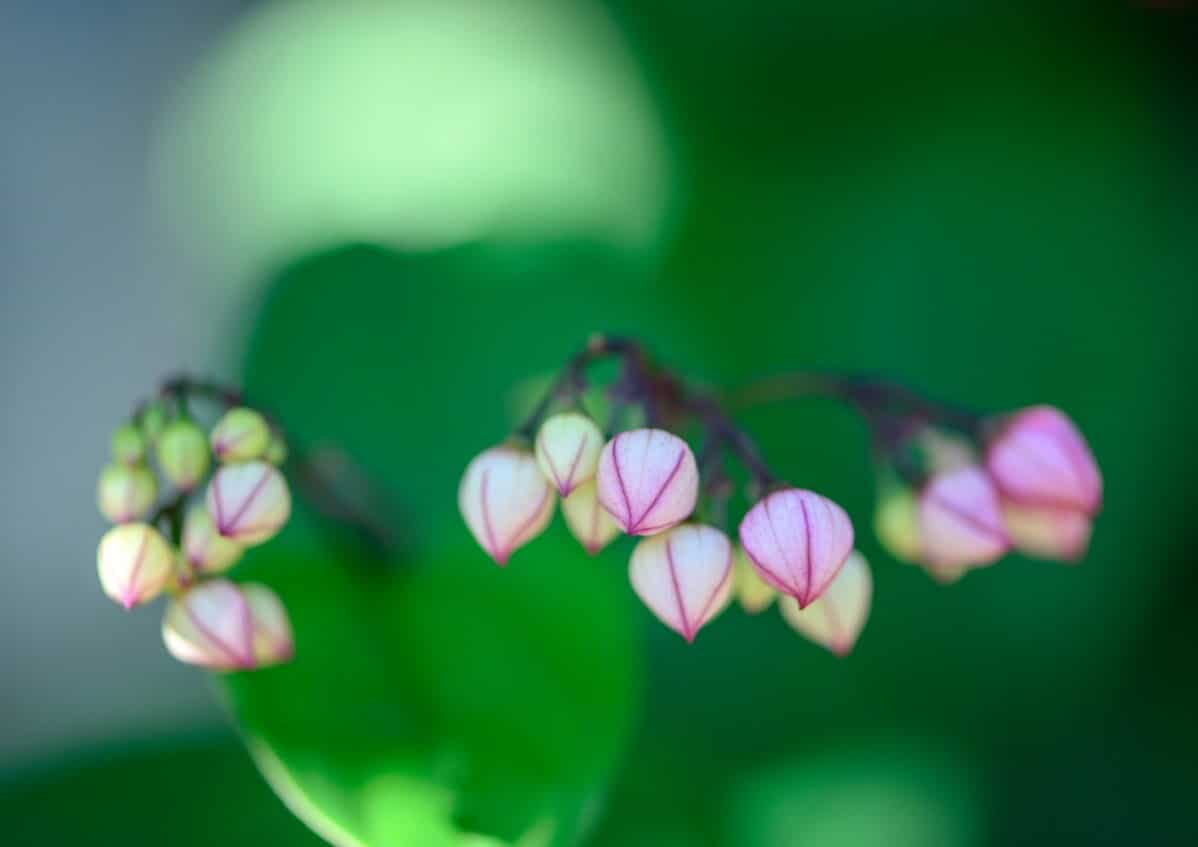
Ground Planting
While bleeding hearts can make great container plants, they can also be very happy in your garden beds. Here are the planting steps.
1. Begin by finding the ideal spot in your woodland garden for your bleeding hearts.
Remember, you need acidic or neutral soil that is moist and drains effectively. Partial or full shade will make it much easier to grow your bleeding hearts. The fussiest varieties of bleeding hearts with respect to shade are the white ones. They need more shade than the pink ones.
2. Dig a hole for each bulb and plant it.
As with container planting, you need to place each bulb roots-down into the ground, then cover it with an inch or so of soil.
3. Space plants properly.
Planting more than one bleeding heart? These plants need room to breathe so that they do not develop rot. So, put at least 2 feet between them. You might consider making it 2 and a half, especially if you have a humid climate (that said, bleeding hearts tend to tolerate humidity okay).
4. Water the bleeding hearts.
After you have finished planting the bleeding hearts, you need to water them.
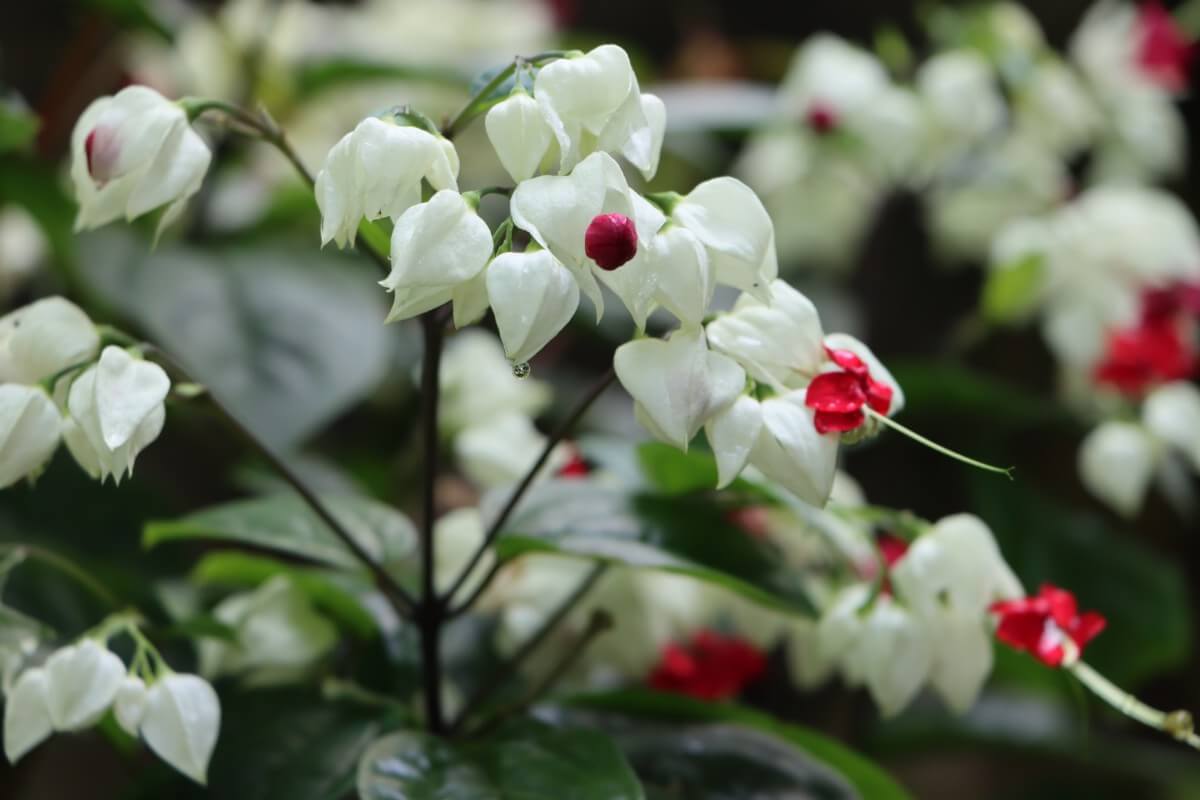
Starting Bleeding Hearts from Seeds
If you want to start your bleeding hearts from seeds instead of bulbs, the right time to sow them is late summer.
1. Choose the right pot.
Starting bleeding hearts from seeds is a little bit different than starting some other plants from seeds. The reason is that typically, when you start plants from seeds, you use a small pot initially, and then you transplant them to a larger one as they grow.
The reason you do not want to do that with bleeding hearts is because they are difficult to transplant successfully. The longer you can leave them in one place, the better.
So, choose a large container for starting your seeds. Something with around a one-gallon volume is suitable.
2. Add seed-starting compost to the pot.
Once you have selected your pot, you need to put in seed-starting compost. Fill it up, leaving roughly an inch at the top.
3. Plant the bleeding heart seeds.
You can plant two or three seeds in a single one-gallon pot. Spacing them evenly, push them down about an eighth of an inch into the compost.
4. Decide where to put the bleeding hearts. Start the warm part of the seed stratification process.
Once the bleeding heart seeds are planted, you have a couple of options with regards to where you put them. You can either put them indoors or outdoors.
If you are going to keep them outdoors, they need to go somewhere warm to start out. If you keep them indoors, you should use a propagation mat for the first month. Set the temperature to 75 degrees Fahrenheit (this gives you some guidance for what kind of outdoor conditions would suffice).
Warm and cool stratification phases help to break dormancy for bleeding heart seeds.
5. Begin the cool phase of the stratification process.
After the warm phase of the stratification process is complete, you can commence with the cool phase. This should last about two months.
Ideally, a refrigerator should be used for cool stratification. If you do not have one large enough to accommodate your pot, you will need to come up with another solution. The best temperature range for this process is 40 to 55 degrees Fahrenheit.
Note that you should not leave the seeds in the dark during this phase. They should still be receiving light, albeit it is ideal if it is indirect.
Throughout both the warm and cold phases of stratification, make sure you check the soil often. Do not let it dry out.
Within 3 to 4 weeks of commencing with cold stratification, your seeds should germinate.
6. Choose a long-term location for your bleeding hearts.
Decide whether you want to grow your bleeding hearts indoors or outdoors, and choose an appropriate spot accordingly.
If you want to transplant the bleeding hearts you grew from seeds, you should wait until the second or third year before you consider doing so. Prior to that, the plants will be too fragile. Even if you have to wait a little longer than you might like, it is best to give them their best chance at surviving the transplant process the transplant process.
The ideal season for transplanting your bleeding heart plants is fall.
How to Care for Bleeding Hearts
Having talked about how to plant bleeding hearts, we can now move on to discuss how you can care for them.
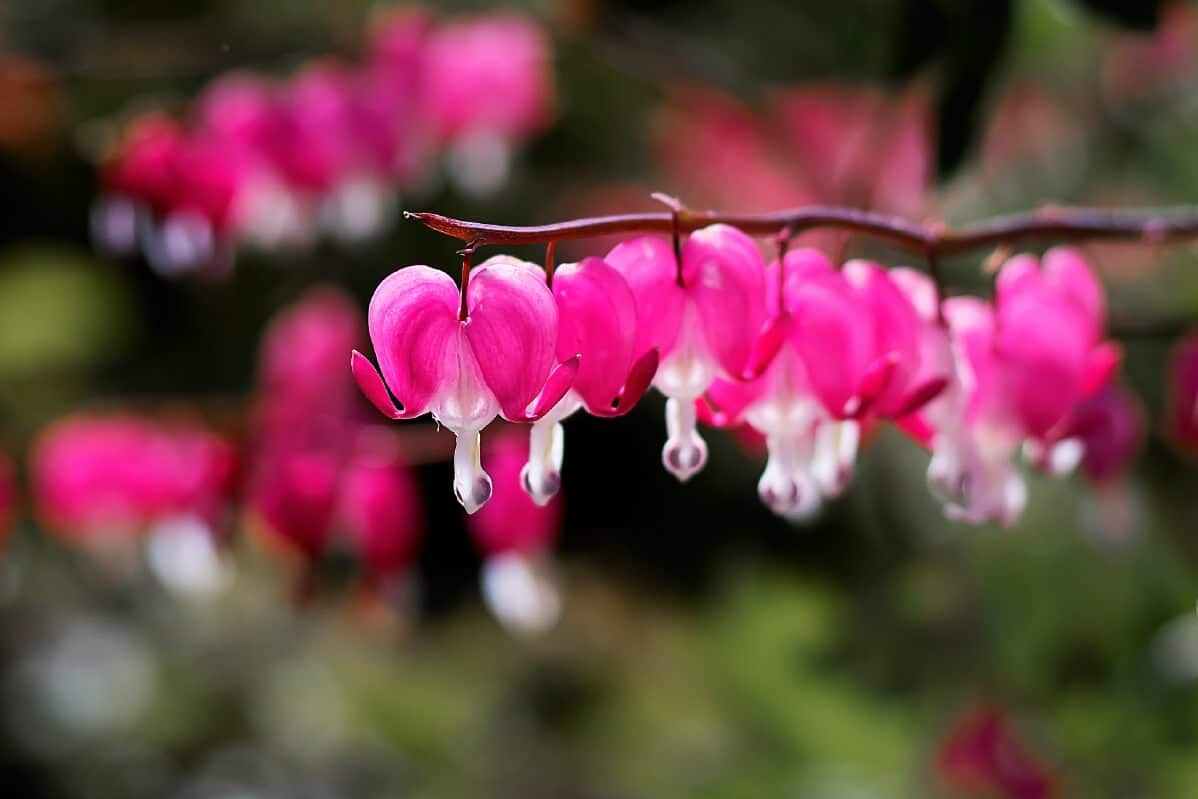
How to Fertilize Bleeding Hearts
It is important for the well-draining soil you provide for your bleeding hearts to be rich with nutrients.
You can use commercial fertilizers with bleeding hearts, but you should not go with those that are overly strong. A better choice is to simply go with compost.
A good time to apply the compost is during the spring. When you first start to see bleeding heart shoots sprouting from the ground, that is the proper time.
How to Mulch Bleeding Hearts
If you are concerned about moisture evaporating too rapidly from your soil, you might want to consider adding a couple inches of mulch. Doing so will help to lock moisture in during a dry spell, and also prevent the ground from heating up as much from the summer sun.
How to Stake Bleeding Hearts
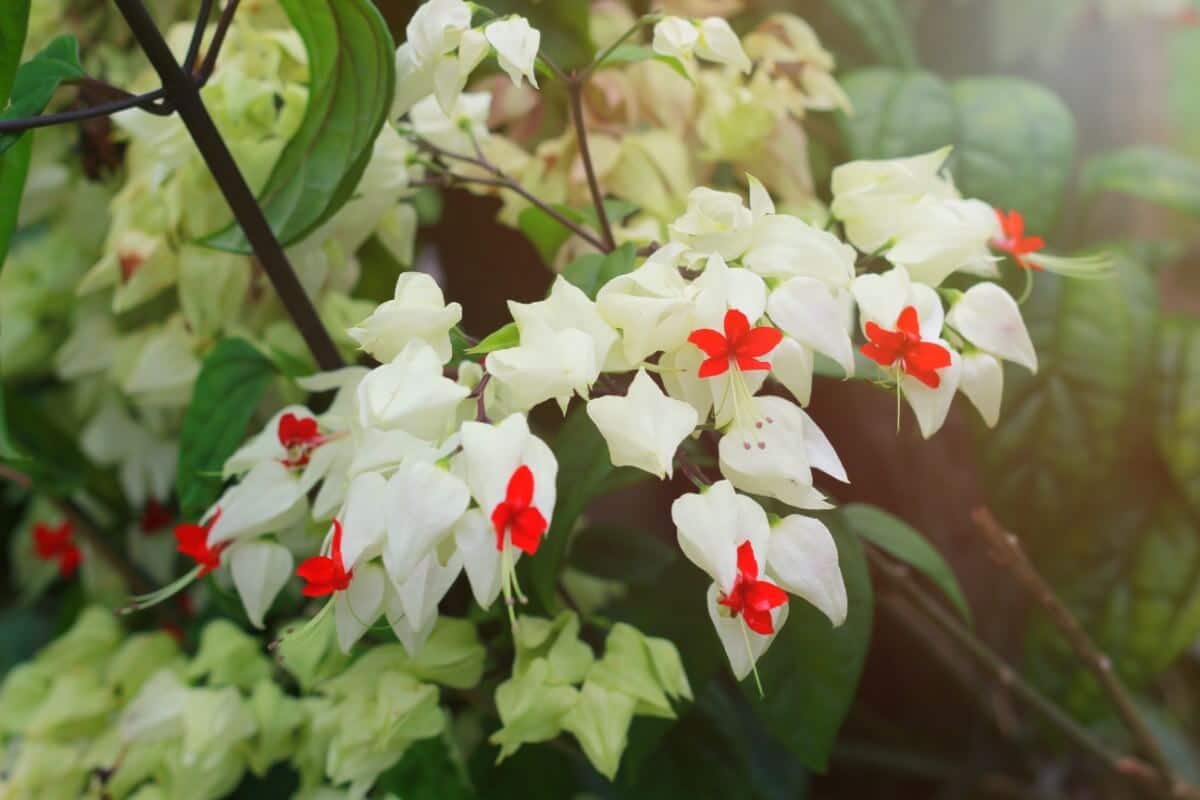
Usually, it is not necessary to stake bleeding hearts. They generally do not get to be all that tall, and the flowers do not exert too much weight on the stems (they are supposed to droop in a gentle arc).
That being said, if your bleeding hearts grow to 3-4 feet in height, staking them might become necessary. But this has more to do with containment than it does to do with supporting their weight.
Also, harsh winds can be a bit much for these beautiful flowers and their arcing stems. So, while they need air circulation, you also need to shelter them from too much wind exposure.
If you are unable to shelter them adequately, staking might help in some situations.
How to Prune Bleeding Hearts
Do you need to prune bleeding hearts? Should you deadhead them? It seems to depend in part upon who you ask.
Indeed, many people say that bleeding hearts only bloom once per season, but some sources report that they can bloom twice—thus making pruning and deadheading sound potentially helpful.
The clearest thing to an answer we have found regarding this issue comes from this forum.
A user posted asking why their bleeding heart seemed to bloom multiple times in one season. Another user named duluthinbloomz4 offered the following reply:
“It's not really blooming again or more than once a season; what you're experiencing is a continuation of blooming during the plant's normal cycle. This is the time they grow, expand, put out new branches and bloom - you're simply seeing new branch growth with new flower buds and blooms, and it could last for a long time.”
Some subsequent responses seemed to indicate, however, that multiple blooms in a year might be possible depending on the variety.
A user named redpeony wrote:
“You may have a fern leaf bleeding heart, rather than the traditional type. I planted a few fern leaf ones last year because they are supposed to have a very long bloom period, if you dead head them. One of King of Hearts variety that I have bloomed quite a long time, but the Bacchanal variety faded quickly after blooming. I am hoping for more from them this year as they settle in.”
So, it seems like your mileage may vary here. There is certainly no harm in attempting to deadhead your bleeding hearts as the blossoms die to see if you get a second bloom out of them, especially if you have a fern leaf variety.
Further research tells us that the “King of Hearts” variety of blooming hearts may have a second bloom depending on where you live.
If you live in a warm part of the world, you might get the second bloom. If you live in a cool part of the world, you might simply get to enjoy non-stop blooms through the summer.
Another variety you can consider for the same purpose is the “Luxuriant” type.
Additionally, if you want the stems for arrangements, you should feel free to remove some. Bleeding hearts add interesting shapes and colors to cut-flower arrangements, providing an appealing contrast with other blossoms.
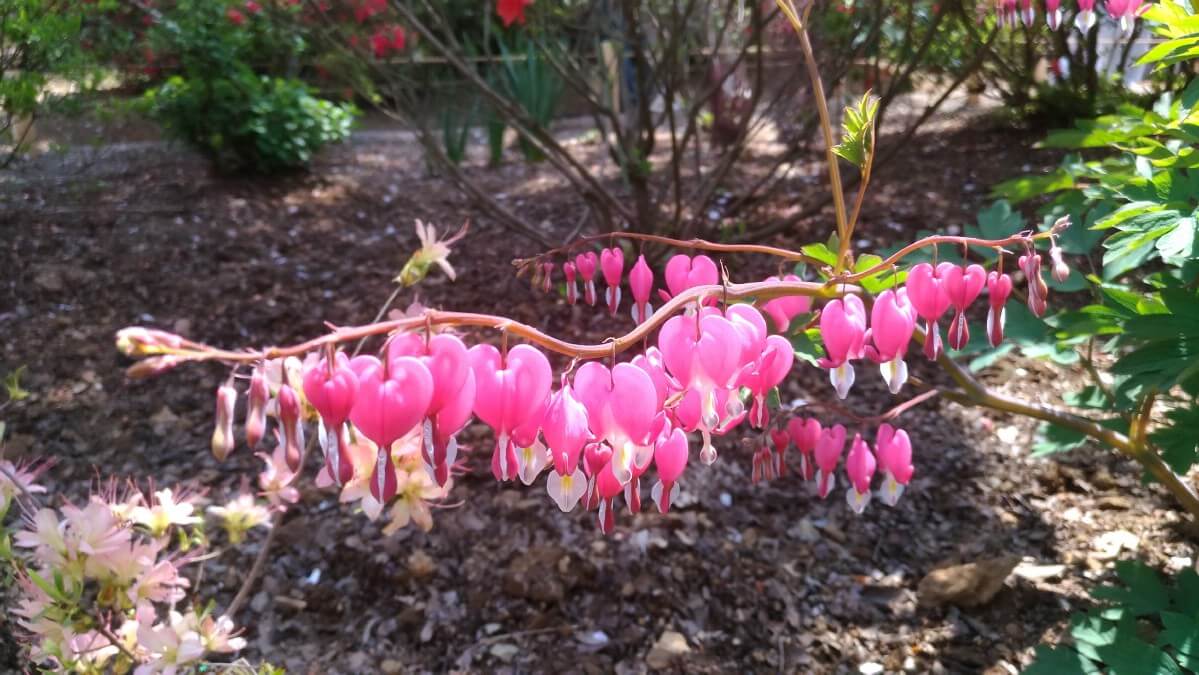
When to Cut Back Bleeding Hearts
Keep an eye on your bleeding hearts as spring turns into summer and the flowers begin to die.
You will notice that the stems and leaves start to yellow. When they do, that is the signal that it is time to trim them back.
At this point, you are going to find yourself with a fairly empty-looking spot in your garden.
If this troubles you, you may want to plant something nearby which will appear right after the bleeding hearts leave a gap. Some perennials are okay for this purpose, so long as they will not intrude on your bleeding hearts, but annuals work really well since they will be out of the way by the end of the bloom season.
Do You Need to Bring Bleeding Hearts Indoors for Winter?
After you cut back your bleeding hearts, what do you need to do to take care of them over the winter? Do you leave them in the ground, or do you bring them indoors?
Generally, you do not want to dig up your bleeding hearts to bring indoors for the winter. Even if we are talking about northern locations, bleeding hearts usually survive the dormant period outside to produce copious blooms the next year.
Plus, as we mentioned before, bleeding hearts do not take well to transplanting. So, you should avoid doing so unless it is absolutely necessary. They will have the best chance of faring well if you just leave them be.
Take note that after you fully cut back your bleeding heart for the winter, it may actually be hard to remember where the plant is located. For that reason, it is a good idea to put some kind of marker over it. That way, you will not remove it or plant something else too close to it by mistake.
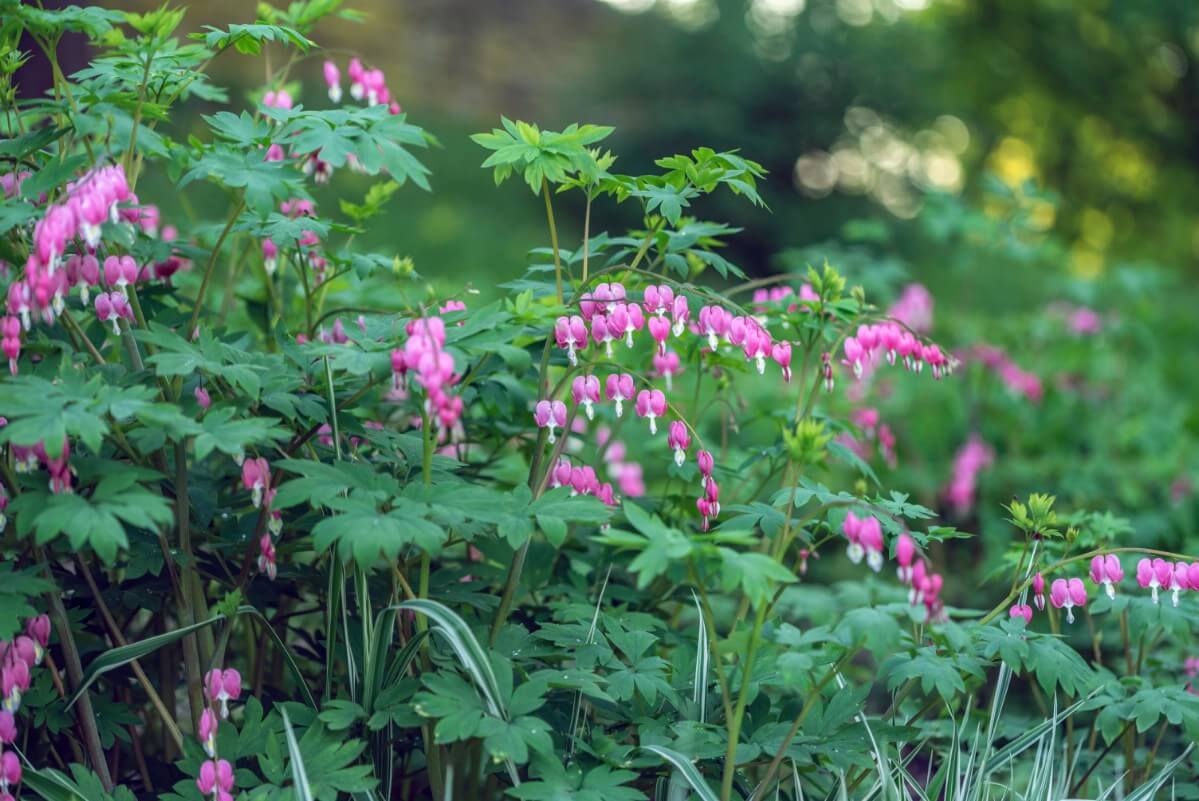
How to Divide and Transplant Bleeding Hearts
Alas, despite the fact that you should try to avoid transplanting bleeding hearts, every few years, you will need to divide them and do it anyway.
There are a couple of times during the year when it is okay to try and divide and transplant your bleeding hearts: autumn or spring.
If you go for the spring season, do it pretty early—otherwise, you will interfere with your treasured blooms.
When you dig up the bulbs to divide them, you will need to be very careful. The roots of these shade-loving plants are notoriously brittle.
Be very gentle as you divide the bulbs and roots. Then, plant each one in fresh soil.
As always, give each plant 2 to 2.5 feet of space so that they will not crowd together. And that brings us around to the section below.
Are Bleeding Hearts Vulnerable to Diseases or Pests?
So, do you need to worry about soil-borne diseases affecting these showy blooms? What about pests?
In the category of diseases, some issues to be on the lookout for are downy mildew, fungal leaf spots, rust, verticillium wilt, and various viruses.
If you find leaf mold, you should remove the leaves in question. Doing so may be able to help protect the health of the rest of the plant.
Situating each perennial plant in well-drained soil and maintaining air-flow around it will help to prevent some of these diseases.
What about pests? Three things that like to eat bleeding heart plants are slugs, snails, and aphids.
What about deer? Bleeding heart flowers are deer resistant, thanks to their toxicity.
Recommended Companion Plants for Bleeding Hearts
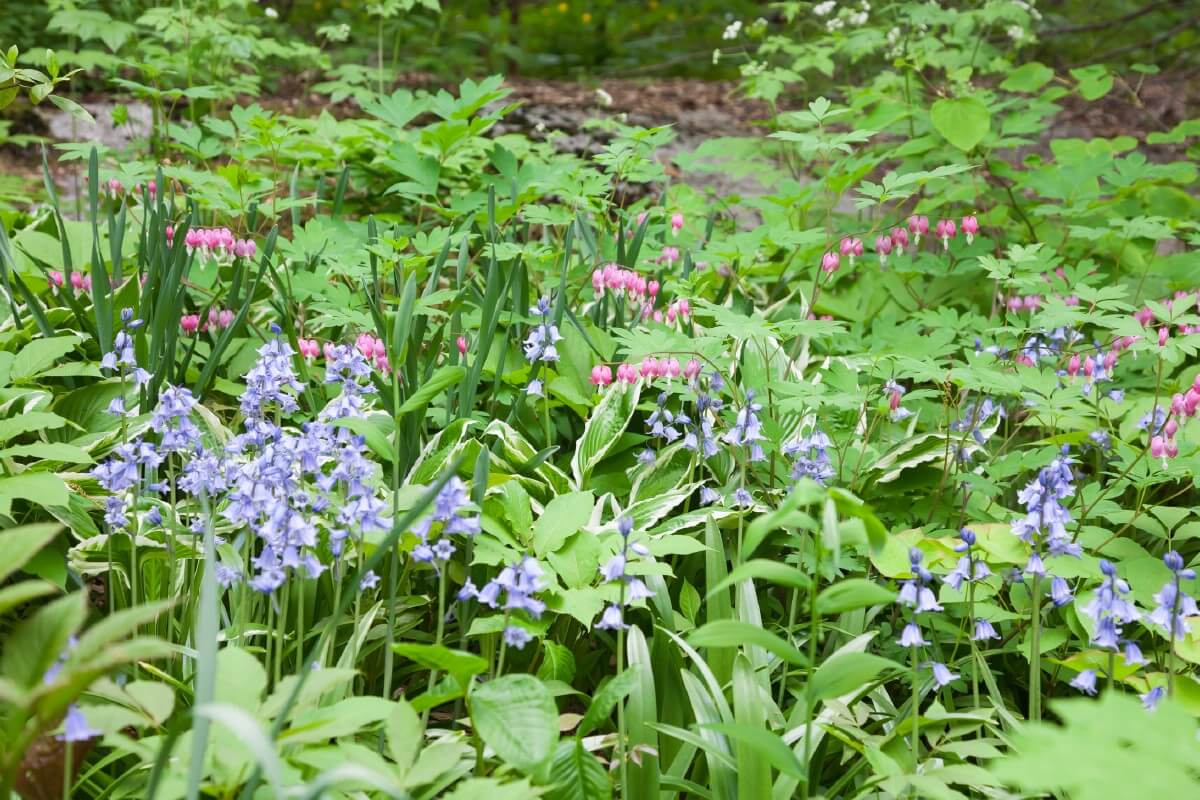
Now you know how to plant and care for bleeding hearts. But what companion plants do well with them?
What you should plant depends in part upon your goals. Many people like to fill in the gap left by bleeding hearts after they are cut back, and opt for plants to serve that purpose. Others might want to plant bleeding hearts protectively around plants that deer might target.
You also can decide on companion plants for bleeding hearts based on aesthetic considerations.
Here are a few ideas:
Hostas. You can expect hostas to start producing their foliage just at about the same time that your bleeding heart foliage needs to be cut away. That means that you can fill out the space nicely for the duration of the season with a hosta plant.
Ferns. People choose ferns as companion plants to bleeding hearts for the same reason they do hostas. The ferns can fill in the gap.
Astilbes. You have to love this dramatic perennial. Feathery blooms in red, pink, white and other shades brings voluminous charm to fill the gap left behind by your bleeding hearts. Like bleeding hearts, they thrive best in moist soil.
Pansies and violets. These flowers bloom in the spring, and deer love to chomp on them. Think about planting them amid some bleeding hearts. The bleeding hearts might help to discourage the deer a bit (though, probably not a lot).
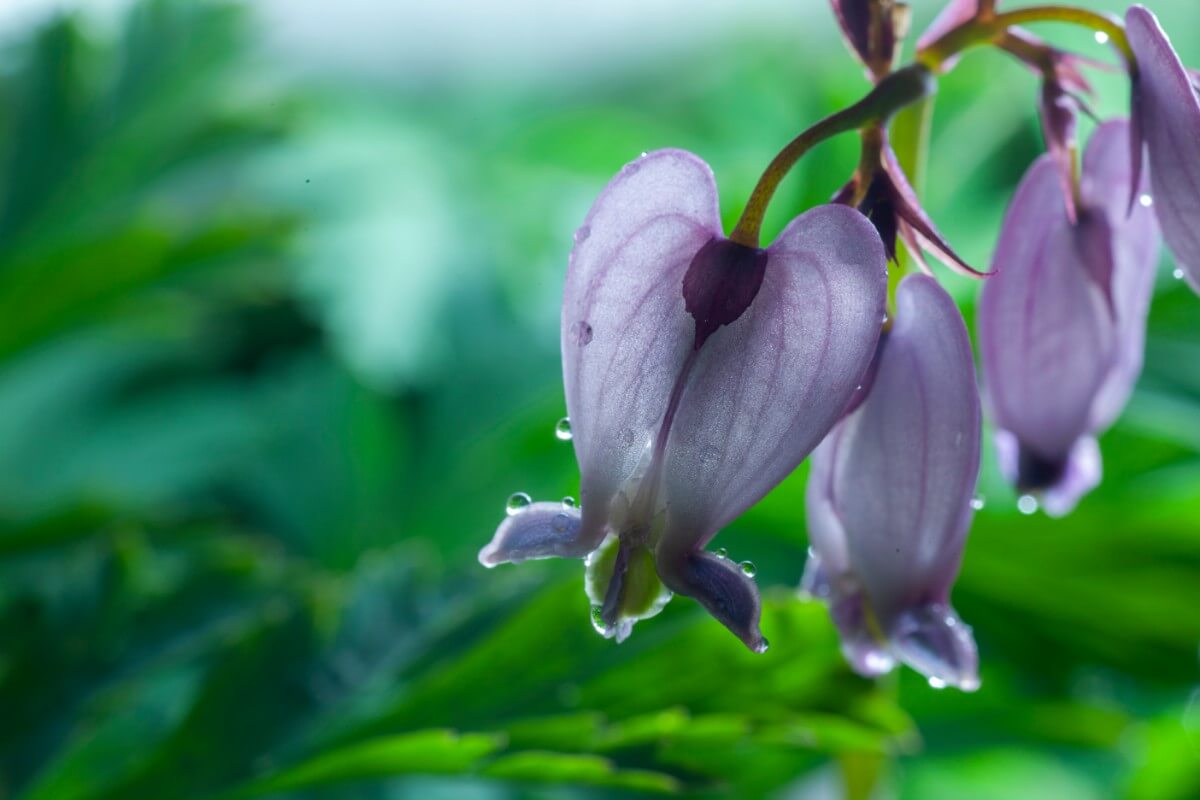
The ideas above are just a few possibilities for companion plants to go with your bleeding hearts. There are so many more possibilities, so do a bit of research and see what you come up with—or just be creative!
Frequently Asked Questions About Growing Bleeding Hearts
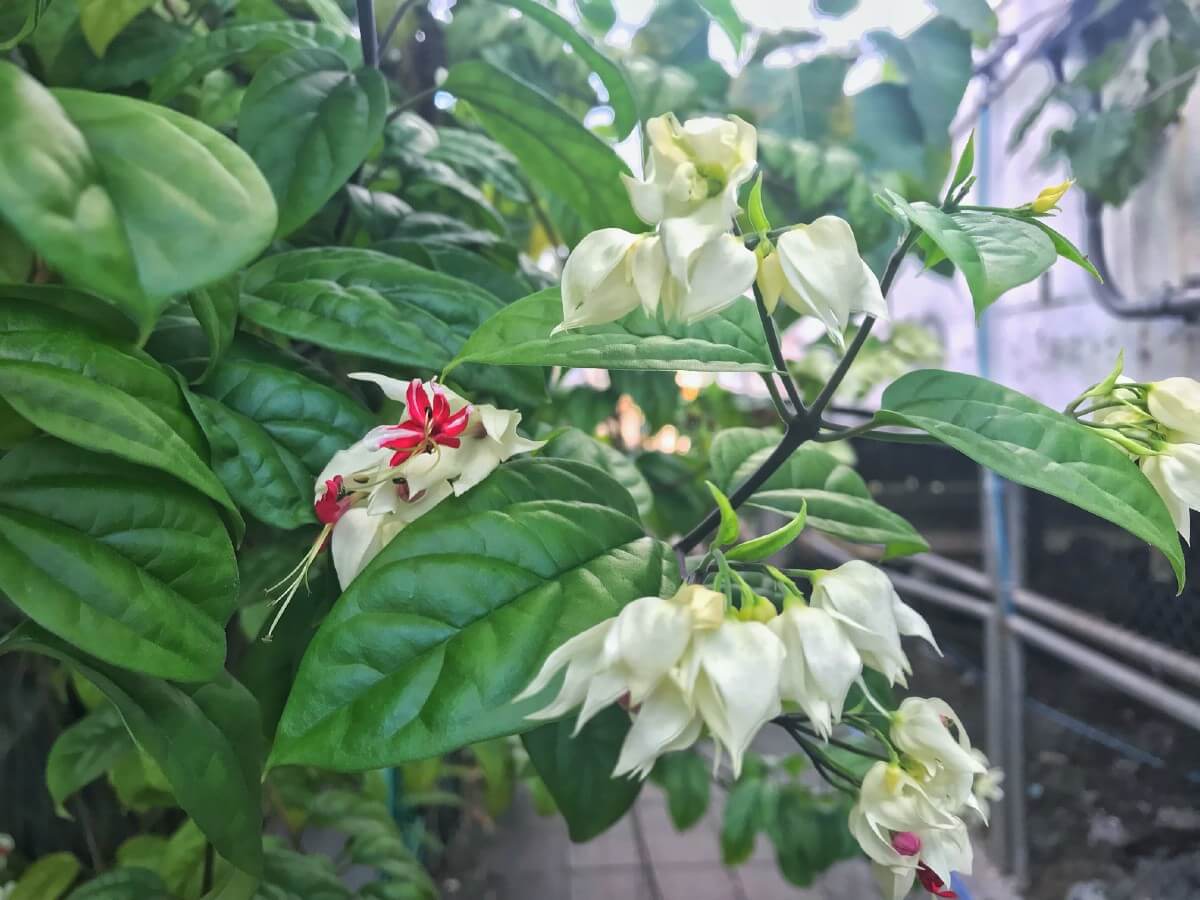
Now you know how to take care of bleeding hearts. But you might still have some questions about these perennials. Let’s take a look at some answers to a few FAQs.
Q: How tall do bleeding hearts get?
A: Different species of this attractive plant reach different heights. At the shorter end, some plants may reach only 6-12 inches. But at the taller end, there are some bleeding heart flowers that can reach 3-4 feet.
Q: What eats bleeding hearts?
A: Since bleeding hearts are toxic to humans and animals, if something is eating yours, it likely is not a mammal. More likely, it is slugs, snails or aphids.
Q: Are bleeding hearts toxic to dogs or cats?
A: Yes, they are. According to Intermountain Pet Hospital, if a pet is poisoned by bleeding heart, it might experience symptoms such as weakness, tremors, clumsiness, seizures, vomiting, diarrhea, respiratory problems, or lethargy.
So, if you have a pet that roams in your yard, you should make sure that they are always under supervision. Otherwise, you should consider choosing a different, non-toxic perennial for your garden.
What if your pet does ingest bleeding hearts, or shows signs of having done so? You should contact your vet straight away, as it is an emergency.
Q: Why are my bleeding hearts not blossoming?
A: Are there no blooms on your bleeding hearts? There are a few possible reasons why this might be happening:
If you planted your bleeding heart this year or last, it is possible it is not ready to bloom yet. It takes one or two seasons before your plant can fully establish itself.
Sometimes bleeding hearts do not blossom because they need dividing. If it has been a few years, consider gently digging them up to check if it is time. Once you divide and transplant them, they may start producing more flowers.
Have boggy soil? Your bleeding heart may not be able to handle it.
Too much sunlight can make it hard for bleeding hearts to produce flowers.
Diseases or infestations can stop bleeding hearts from producing blooms as well.
So, you will need to take appropriate steps based on the problem you identify. Hopefully, if you do, you can restore blossoms to your bleeding heart the next year.
Q: My skin is irritated when I touch bleeding heart plants. What should I do?
A: If you are sensitive to bleeding heart plants, you are not alone. It is a common reaction. What you should do is wear gloves when you need to handle them to avoid contact with sensitive skin. Thankfully, you should not need to do so very often. They are not all that high-maintenance.
Q: What is best to plant with bleeding hearts?
A: While there are many great options, you might want to pick hostas, ferns, or other late-emerging plants with ferny foliage that can fill out the space that bleeding hearts leave when they wilt.
Q: Are bleeding hearts annual or perennial?
A: Bleeding hearts are perennials. That means that when you plant one, it will bloom again year after year.
Where to Buy Bleeding Hearts
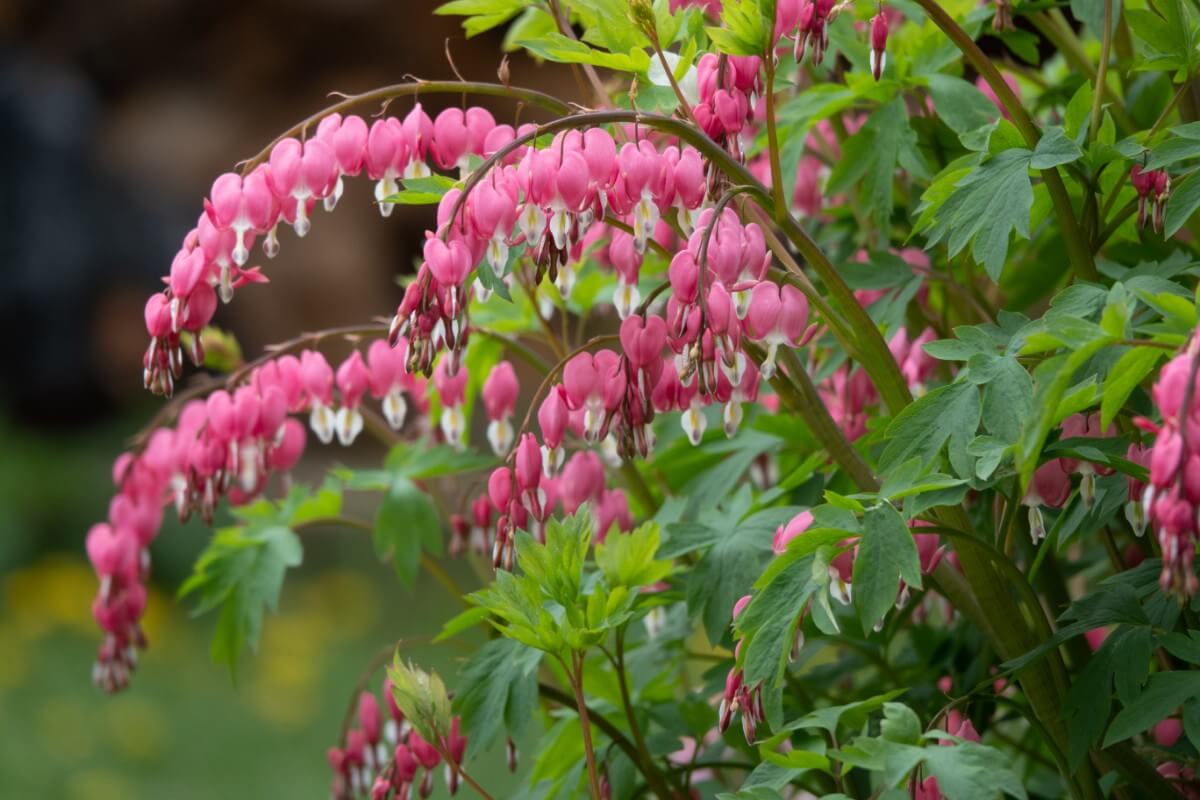
Can’t wait to plant bleeding hearts in a shady spot in your own garden? You can shop for bleeding hearts at a local garden store or online. To order bleeding hearts now, click the link below.

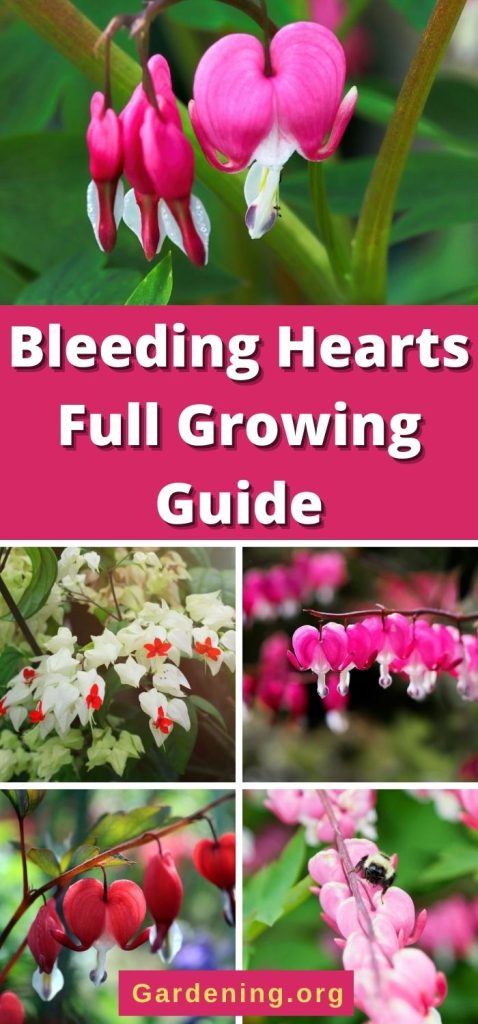
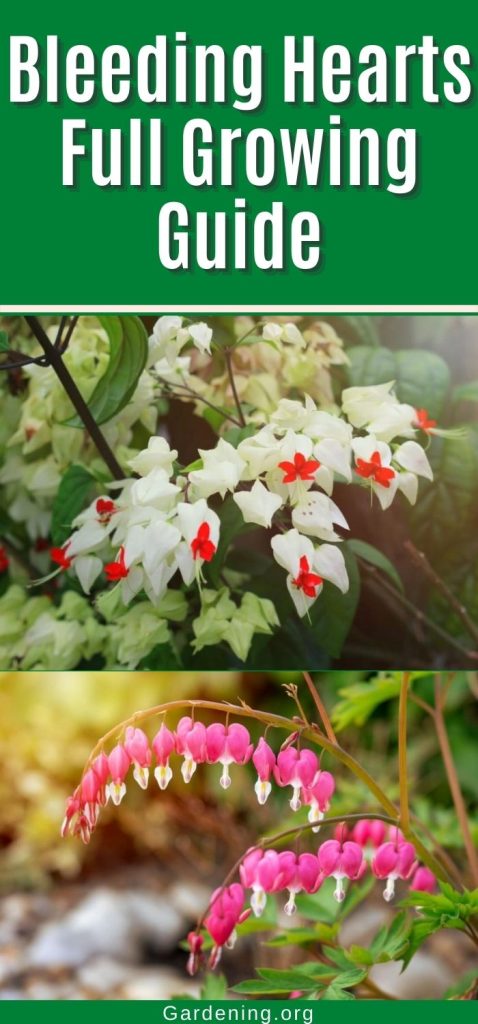


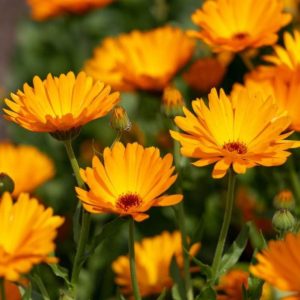
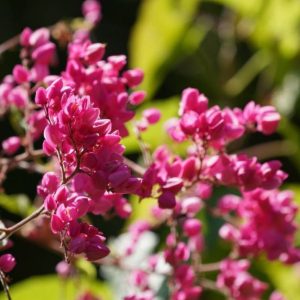
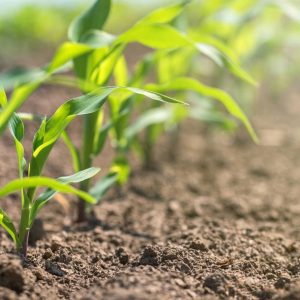
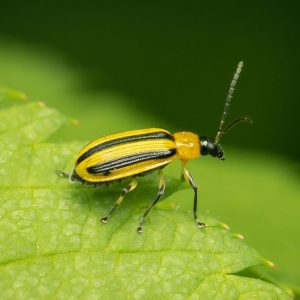
Melinda Daniels
Where do I buy them
Mary Ward
Bleeding Hearts are usually pretty easy to find. Local garden centers usually carry them. You can order on Amazon or through any number of plant catalogs and websites.
Here's a link to a classic pink offered by Holland Bulb: https://amzn.to/4mJxLnW
Here's a link to a pretty all white variety: https://amzn.to/43RkQsq